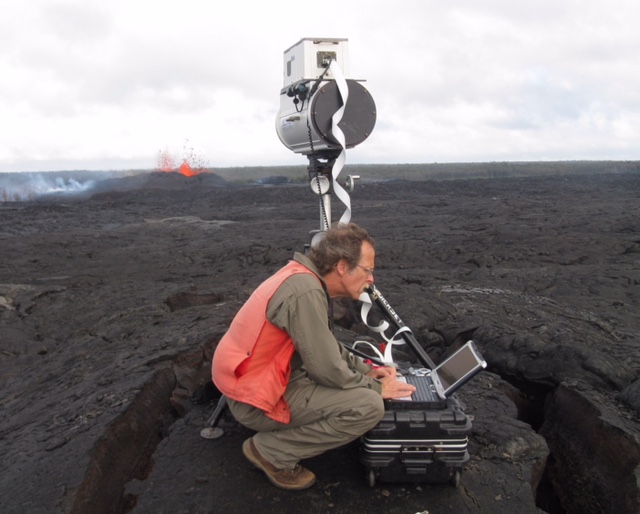HVO Celebrates Career of Geochemist Jeff Sutton

Jeff Sutton, who recently retired from the USGS, measured gas emissions during the March 2011 Kamoamoa fissure eruption on Kilauea’s East Rift Zone. Sutton, who served as a gas geochemist at the Hawaiian Volcano Observatory for 24 years, plans to continue working on Hawaiian volcanoes for a while longer as a USGS scientist emeritus. USGS photo.
Hawaiian Volcano Observatory (HVO) staff, alumni and friends recently gathered to honor the long and fruitful career of Jeff Sutton, our recently retired colleague.
The gathering was large and full of aloha—a testament to the high regard and affection we hold for Jeff and his 38 years of service as a gas geochemist in the U.S. Geological Survey (USGS).
Throughout his career, Jeff strived to improve methods of sampling volcanic gasses and our understanding of what the gasses can tell us about eruptive processes. He also recognized that volcanic gas, especially chronic exposure from long-lived eruptions, such as Kīlauea’s ongoing East Rift Zone and summit eruptions, poses a health hazard to the population. His work in monitoring gas emissions and with health officials has been a huge contribution to the people of Hawaiʻi and to the USGS Volcano Hazards Program.
Jeff’s impact extends far beyond Hawaiʻi, as he has worked at active volcanic systems throughout the western U.S. and around the world. For example, he has conducted gas studies in the Cascades (most notably, at Mount St. Helens), Long Valley, Yellowstone, Alaska, Indonesia, Italy, South America, Japan and the Marianas Islands.
The roots of Jeff’s illustrious career lie in Reston, Virginia, where he got his first USGS job. While he was still attending George Mason University to earn his degree in chemistry, he was hired as a Physical Science Aid to assist in a study of methane solubility. His work ethic, enthusiasm and creativity so impressed his supervisor and colleagues that they rehired him on a new project after the methane project ended.
The new project was inspired by the 1980 eruption of Mount St. Helens, when the hazardous potential of volcanoes was brought into the limelight.
The focus of the project was to design, assemble and test sensors and instruments for continuous gas sampling. This became one of the cornerstones of Jeff’s career.
He is a pioneer in the field of continuous gas monitoring at volcanoes. While others climbed volcanoes to collect flasks full of gas that they brought to the laboratory for analysis, Jeff brought the laboratory to the volcano.
This was not an easy task, because volcanic gasses are extremely acidic. They wreak havoc with electronics and can corrode metal within hours. Despite the challenges, Jeff continued to develop instruments that could withstand such harsh environments.
Jeff realized that field-based instrumentation has several advantages over intermittent measurements and laboratory analyses of volcanic gasses. First, it alleviates the need for hazardous visits to a volcanic site for the purpose of gas measurements and sampling. Secondly, continuous measurements provide a more detailed view of how gas concentrations and compositions change with changing volcanic activity than occasional samples. Finally, by sending data to the observatory in real-time, we can get the earliest possible indication of any change in gas emissions that could signal a change in eruptive activity.
The continuous sampling project led to Jeff’s appointment to a position at the Cascades Volcano Observatory. In 1993, after another stint in Reston, he was assigned to a 2-3 year tour at HVO. Fortunately for his colleagues at HVO, that “temporary” tour lasted 24 years!
Our luck continues, as Jeff plans to continue working at HVO intermittently as a “scientist emeritus”—meaning that he will volunteer his time to continue the work he loves and to finish important projects.
Jeff is the perfect example of an observatory scientist: curious, creative, collaborative, interdisciplinary, applied, passionate about his work, and kind and caring towards his colleagues and the public that we serve.
We also appreciate his quick wit and sense of humor, which brighten our workplace.
For fans of our Volcano Watch series, Jeff authored more than three dozen articles during his time at HVO, with titles such as: “Prodigious plumes present provocative puzzle.”
We wish Jeff all the best in his retirement, which will allow him to spend more time with the people and activities he loves. But we’re grateful that he plans to stay with us for a while longer as an HVO emeritus scientist.
Volcano Watch is a weekly article and activity update written by U.S. Geological Survey`s Hawaiian Volcano Observatory scientists and colleagues.












